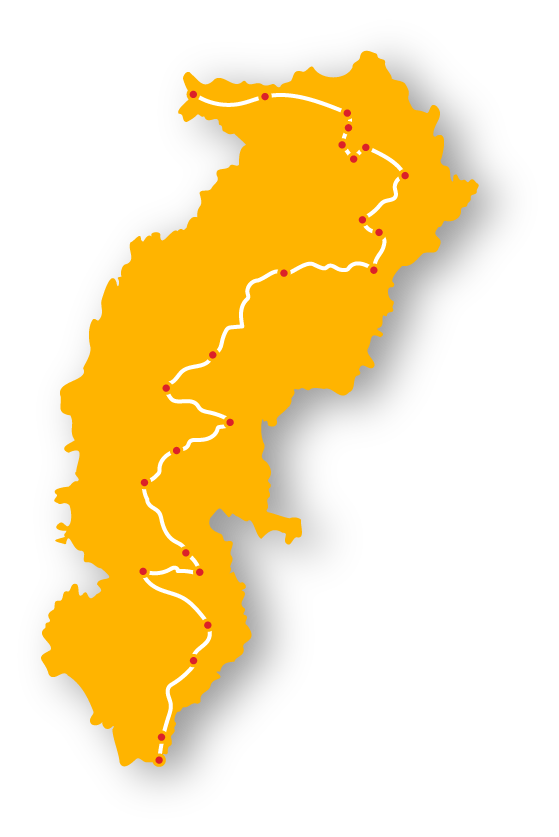
- Rama Raksha Stotra

Chhattisgarh has a deep association with Lord Ram. A large part of Ramayan tells the story of Ram’s vanvas (exile). During this exile of 14 years, it is believed that Ram spent around 10 years in the forests of Dandakaranya (present day Chhattisgarh).
The state abounds with stories of Ram, Laxman and Sita interacting with the people of Chhattisgarh during their exile. Stories and songs inspired by Lord Ram have been narrated and sung in communities and passed on through generations as part of the oral tradition. The legends and tales of Lord Ram in exile celebrate Chhattisgarh as the place where Prince Ram exhibited the qualities of Maryada Purushottam- the ideal man and ruler.
In addition, Chhattisgarh is the nanihal (mother’s birth home) of Ram. The Ramayan records that Kaushalya, Ram’s mother was born here. Her relationship with her son and the values she inculcated in him are universally appreciated throughout India.
With so many stories and legends, Chhattisgarh becomes the ideal destination for devotees of Lord Ram who seek places of importance in His life.
This is an opportunity for the people of Chhattisgarh to take ownership of Lord Ram’s legacy, building on the slogan of the present government - “Baat Hai Abhiman Ki, Chhattisgarh Ke Swabhiman Ki”.
Honouring this bond with Lord Ram, the Chhattisgarh government headed by Chief Minister Shri Bhupesh Baghel, has set up the Ram Van Gaman Paripath identifying all locations within Chhattisgarh where Lord Ram has traveled to or lived during his exile and developing a tourism circuit connecting all major locations from the north to south of Chhattisgarh.
Chhattisgarh is the first state that has taken such a step to honour Lord Ram. While there are many pilgrimage places all over India, there is no circuit encompassing multiple destinations that are related to Lord Ram’s life.
In each of these locations, several projects have been initiated to cater to tourists and pilgrims. These include:
In the first phase of the project, ine Of the selected places falling on the forest routeN taken by Lord Ram are being developed as tourist destinations at a cost of Rs 137.45 crore. The developments are proposed keeping in mind the Ramayankaleen theme of the project.

Lord Ram made his appearance into Chhattisgarh from Koriya district. The Seetamadhi-Harchauka is famous as his first halt. Located on the banks of Mawai River, the Seetamadhi-Harchauka’s cave houses 17 chambers inside it. This divine place is known as Seeta’s kitchen. Chambers of the cave have 12 Shivlings. People believe that Lord Ram worshipped the Shivling during his stay in the cave.
Moving onward with his journey, Ram left Ghaghra and arrived at Kotadol, crossing the Ramgarh hills in Sarguja district. Ramgarh is known for Sita Bengra and Jogimara caves. Lord Ram spent a few days of his exile along with his wife Seeta and brother Lakshman in these caves. The locals recount many stories about the caves passed down to them through generations.
The great poet Kalidasa mentions scenes from this location in his beautiful work of literary art ‘Meghdootam’. Ramgarh is also renowned for one of the oldest ‘natyashala’ (amphitheatre) where Meghdootam was composed.
Shivrinarayan is a small town located at the Triveni Sangam (the intersection of 3 rivers), Shivnath, Jonk and Mahanadi in the Janjgir Champa district. The word Shivrinarayan is a fusion of two words: Shabari and Narayana. This place is renowned for its unconditional love with Mata Shabari being an embodiment of motherhood and simplicity.
There is an ancient banyan tree in the Shivrinarayan temple courtyard. Its leaves are unique in shape. Shabari, an ardent devotee of Lord Ram became ecstatic when he visited her ashram and offered the handpicked jujubes to him. She had tasted them one by one to ensure that she fed only the sweetest ones to Ram. The tale of Shabari and Lord Ram is still cherished for its emotional appeal.
Turturiya is a small village located on the banks of the river Balamdehi in Baloda Bazar district. This is a fabled land of great sage Valmiki whose ashram stands atop a hill in proximity to the temples. This is also said to be the place where Mata Seeta gave birth to her twins – Luv and Kush. This place is of great religious and cultural significance as it here where Maharishi Valmiki through his epic poem Ramayana revealed the legend of Lord Ram to the world.
The water streaming through the river makes a distinct turtur sound, giving the place its unique name. Turturiya is being developed as a tourist pilgrimage.
Chandkhuri, a small village in Raipur obtains its name from Chandrapuri which was ruled by the Chandravanshi kings in ancient times. Chandkhuri is regarded as Lord Ram’s maternal home, as his mother Kaushalya was born here. This place houses the ancient Mata Kaushalya temple; the only one in the world dedicated to her.
Rajim is a town in Gariaband district and is strategically located at the confluence of the Mahanadi, Sondhur and Pairi rivers. A confluence of three rivers is called Triveni Sangam in Hindu tradition and is considered holy.
Identified under the Ram Van Gaman Tourism Circuit, this place is widely accepted as ‘Prayag of Chhattisgarh’. Rajim is considered one of the important pilgrimage sites. Lord Ram spent some time of his exile in the ashram of the great sage Lomash Rishi.
It is believed that Mata Seeta established the Shivling in the confluence and she along with Lord Ram and his brother Lakshman worshipped the deity Lord Shiva here. The Shivling established by her is now housed inside the famous Kuleshwar Mahadev temple.During floods, the temple gets submerged but the Shivling does not.
Sihawa in Dhamtari district is revered as the place of seven greatest sages Sapt Rishis named Shringi Rishi, Muchkund Rishi, Agastya Rishi, Angira Rishi, Kankar Rishi, Sharabhang Rishi and Gautama Rishi whose ashrams are situated on seven different hills. As folklore goes, Lord Ram spent a significant amount of his time at this place meeting and consulting all the seven rishis. Sihawa is the place of origin of the divine Mahanadi River, which is considered sacred in Chhattisgarh and Odisha.
Jagdalpur, a city located in the famous Bastar district is abode of waterfalls, caves, wildlife, temples and historic monuments. It was also the capital of the erstwhile princely state of Bastar.
One of the many phenomenal festivals of Jagdalpur is the ‘Bastar Dussehra’ a 500-year-old festival that runs for 75 days a year. It is believed that Lord Ram spent his time at Chitrakote and in the amazing Kutumsar Caves inside Kanger Valley Forest. These caves are situated near the maginificent Tirathgarh Waterfall and is located at a distance of 40 KM from Jagdalpur.
There is a popular belief among the locals of South Bastar, that Ramaram in the Sukma district, houses the footprints of Lord Ram. It is also believed that here he worshipped Bhoomi Devi, a Hindu deity representing the earth.
Ramaram is also home to the famous Chittamittin temple. On the occasion of Ramanavami, a mega fair is organised by the local tribal community at this place to worship the deity Chittamittin. The fair is also attended by various tribal communities from nearby areas and tourists.